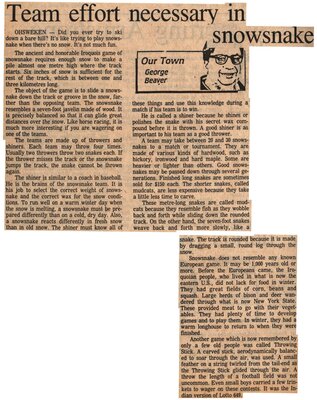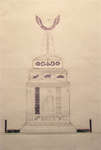"Team Effort Necessary in Snowsnake"
- Full Text
- Team effort necessary in snowsnake
OHSWEKEN - Did you ever try to ski down a bare hill? It's like trying to play snowsnake when there's no snow. It's not much fun.
The ancient and honorable Iroquois game of snowsnake requires enough snow to make a pile almost one metre high where the track starts. Six inches of snow is sufficient for the rest of the track, which is between one and three kilometres long.
The object of the game is to slide a snowsnake down the track or groove in the snow, farther than the opposing team. The snowsnake resembles a seven-foot javelin made of wood. It is precisely balanced so that it can glide great distances over the snow. Like horse racing, it is much more interesting if you are wagering on one of the teams.
The teams are made up of throwers and shiners. Each time may throw four times. Usually two throwers throw two snakes each. If the thrower misses the track or the snowsnake jumps the track, the snake cannot be thrown again.
The shiner is similar to a coach in baseball. He is the brains of the snowsnake team. It is his job to select the correct weight of snowsnake and the correct wax for the snow conditions. To run well on a warm winter day when the snow is melting, a snowsnake must be prepared differently than on a cold, dry day. Also, a snowsnake reacts differently in fresh snow than in old snow. The shiner must know all of these things and use this knowledge during a match if his team is to win.
He is called a shiner because he shines or polishes the snake with his secret wax compound before it is thrown. A good shiner is as important to his team as a good thrower.
A team may take between 20 and 30 snowsnakes to a match or tournament. They are made of various kinds of hardwood, such as hickory, ironwood and hard maple. Some are heavier or lighter than others. Good snowsnakes may be passed down through several generations. Finished long snakes are sometimes sold for $150 each. The shorter snakes, called mudcats, are less expensive because they take a little less time to carve.
These metre-long snakes are called mud-cats because they resemble fish as they wobble back and forth while sliding down the rounded track. On the other hand, the seven-foot snakes weave back and forth more slowly, like a snake. The track is rounded because it is made by dragging a small, round log through the snow.
Snowsnake does not resemble any known European game. It may be 1,000 years old or more. Before the Europeans came, the Iroquoian people, who lived in what is now the eastern U.S., did not lack for food in winter. They had great fields of corn, beans and squash. Large herds of bison and deer wandered through what is now New York State. These provided meat to go with their vegetables. They had plenty of time to develop games and to play them. In winter, they had a warm longhouse to return to when they were finished.
Another game which is now remembered by only a few old people was called Throwing Stick. A carved stick, aerodynamically balanced to soar through the air, was used. A small feather on a string twirled from the tail-end as the Throwing Stick glided through the air. A throw the length of a football field was not uncommon. Even small boys carried by a few trinkets to wager on these contests. It was the Indian version of Lotto 649.
- Mystery Question
- When was this article published?[Please answer by clicking on the Comments tab]
- Creator
- Beaver, George, Author
- Media Type
- Newspaper
- Item Types
- Articles
- Clippings
- Description
- "Did you ever try to ski down a bar hill? It's like trying to play snowsnake when there's no snow. It's not much fun."
- Subject(s)
- Local identifier
- SNPL002627v00d
- Collection
- Srapbook #1 by Janet Heaslip
- Language of Item
- English
- Geographic Coverage
-
-
Ontario, Canada
Latitude: 43.06681 Longitude: -80.11635
-
- Creative Commons licence
 [more details]
[more details]- Copyright Statement
- Public domain: Copyright has expired according to Canadian law. No restrictions on use.
- Copyright Holder
- Brantford Expositor
- Contact
- Six Nations Public LibraryEmail:info@snpl.ca
Website:
Agency street/mail address:1679 Chiefswood Rd
PO Box 149
Ohsweken, ON N0A 1M0
519-445-2954



